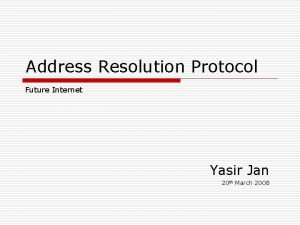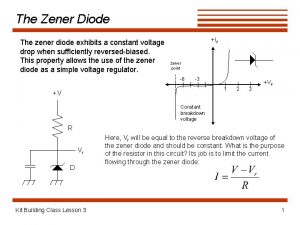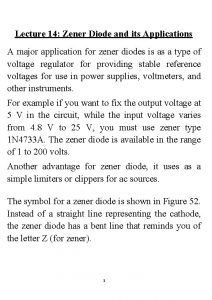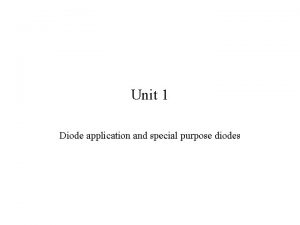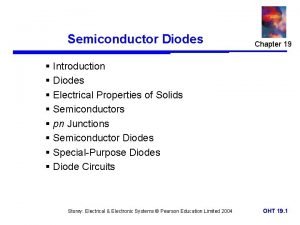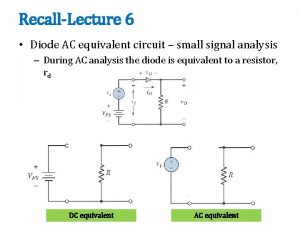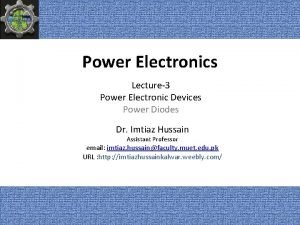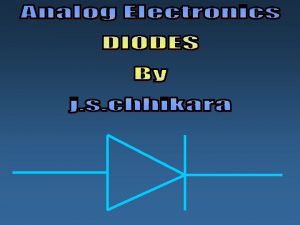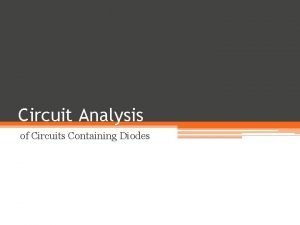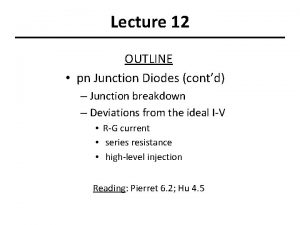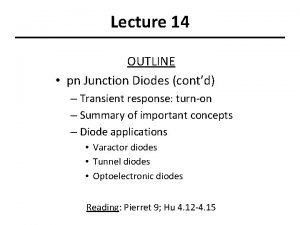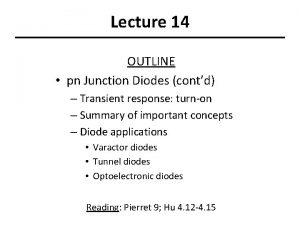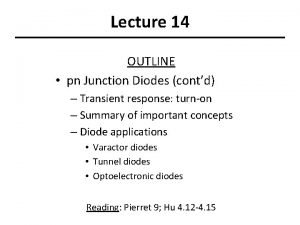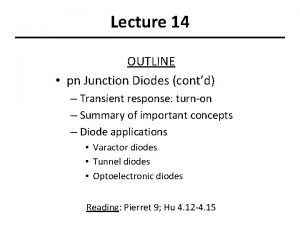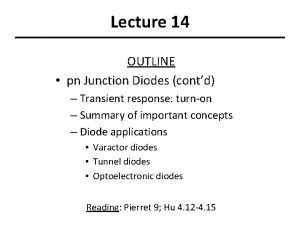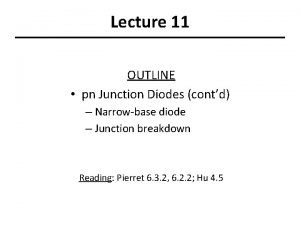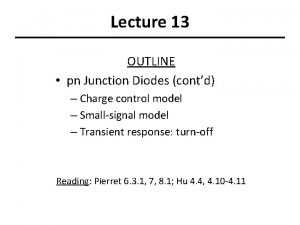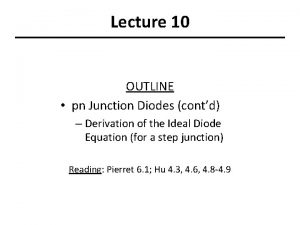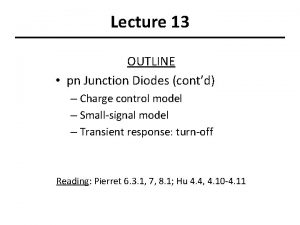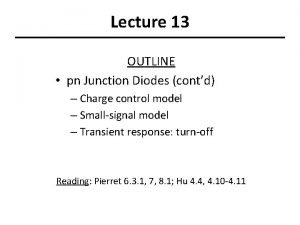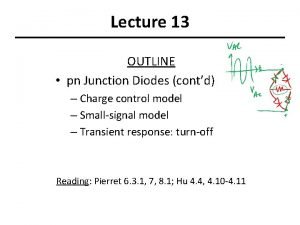Lecture 14 OUTLINE pn Junction Diodes contd Transient















- Slides: 15

Lecture 14 OUTLINE • pn Junction Diodes (cont’d) – Transient response: turn-on – Summary of important concepts – Diode applications • Varactor diodes • Tunnel diodes • Optoelectronic diodes Reading: Pierret 9; Hu 4. 12 -4. 15

Turn-On Transient Consider a p+n diode (Qp >> Qn): Dpn(x) i(t) t xn x t For t > 0: EE 130/230 A Fall 2013 v. A(t) Lecture 14, Slide 2

• By separation of variables and integration, we have • If we assume that the build-up of stored charge occurs quasi-statically so that then EE 130/230 A Fall 2013 Lecture 14, Slide 3

• If tp is large, then the time required to turn on the diode is approximately DQ/IF EE 130/230 A Fall 2013 Lecture 14, Slide 4

Summary of Important Concepts • Under forward bias, minority carriers are injected into the quasi-neutral regions of the diode. • The current flowing across the junction is comprised of hole and electron components. – If the junction is asymmetrically doped (i. e. it is “one-sided”) then one of these components will be dominant. • In a long-base diode, the injected minority carriers recombine with majority carriers within the quasineutral regions. EE 130/230 A Fall 2013 Lecture 14, Slide 5

• The ideal diode equation stipulates the relationship between JN(-xp) and JP(xn): Ø For example, if holes are forced to flow across a forward-biased junction, then electrons must also be injected across the junction. EE 130/230 A Fall 2013 Lecture 14, Slide 6

• Under reverse bias, minority carriers are collected into the quasi-neutral regions of the diode. – Minority carriers generated within a diffusion length of the depletion region diffuse into the depletion region and then are swept across the junction by the electric field. ®The negative current flowing in a reverse-biased diode depends on the rate at which minority carriers are supplied from the quasi-neutral regions. • Electron-hole pair generation within the depletion region also contributes negative diode current. EE 130/230 A Fall 2013 Lecture 14, Slide 7

pn Junction as a Temperature Sensor C. C. Hu, Modern Semiconductor Devices for ICs, Figure 4 -21 EE 130/230 A Fall 2013 Lecture 14, Slide 8

Varactor Diode • Voltage-controlled capacitance – Used in oscillators and detectors (e. g. FM demodulation circuits in your radios) – Response changes by tailoring doping profile: EE 130/230 A Fall 2013 Lecture 14, Slide 9

Optoelectronic Diodes EE 130/230 A Fall 2013 Lecture 14, Slide 10 R. F. Pierret, Semiconductor Fundamentals, Figure 9. 2

Open Circuit Voltage, VOC EE 130/230 A Fall 2013 Lecture 14, Slide 11 C. C. Hu, Modern Semiconductor Devices for ICs, Figure 4 -25(b)

Solar Cell Structure Cyferz at en. wikipedia EE 130/230 A Fall 2013 Lecture 14, Slide 12

Textured Si surface for reduced reflectance • Achieved by anisotropic wet etching (e. g. in KOH) M. A. Green et al. , IEEE Trans. Electron Devices, Vol. 37, pp. 331 -336, 1990 P. Papet et al. , Solar Energy Materials and Solar Cells, Vol. 90, p. 2319, 2006 EE 130/230 A Fall 2013 Lecture 14, Slide 13

p-i-n Photodiodes • W Wi-region, so most carriers are generated in the depletion region faster response time (~10 GHz operation) • Operate near avalanche to amplify signal EE 130/230 A Fall 2013 Lecture 14, Slide 14 R. F. Pierret, Semiconductor Fundamentals, Figure 9. 5

Light Emitting Diodes (LEDs) • LEDs are made with compound semiconductors (direct bandgap) R. F. Pierret, Semiconductor Fundamentals, Figure 9. 13 R. F. Pierret, Semiconductor Fundamentals, Figure 9. 15 EE 130/230 A Fall 2013 Lecture 14, Slide 15
 Alliance future internetlapowskyprotocol
Alliance future internetlapowskyprotocol Whats a subordinating conjunction
Whats a subordinating conjunction Bjt transistor notes
Bjt transistor notes 01:640:244 lecture notes - lecture 15: plat, idah, farad
01:640:244 lecture notes - lecture 15: plat, idah, farad Lecture outline example
Lecture outline example Lecture outline example
Lecture outline example Lecture outline meaning
Lecture outline meaning Lecture outline example
Lecture outline example Zener diode exhibit
Zener diode exhibit Zener diode application
Zener diode application Special purpose diodes
Special purpose diodes Introduction to diodes
Introduction to diodes The ac equivalent of the diode is a resistor
The ac equivalent of the diode is a resistor Power diode
Power diode What are diodes made of
What are diodes made of Circuit analysis with diodes
Circuit analysis with diodes
